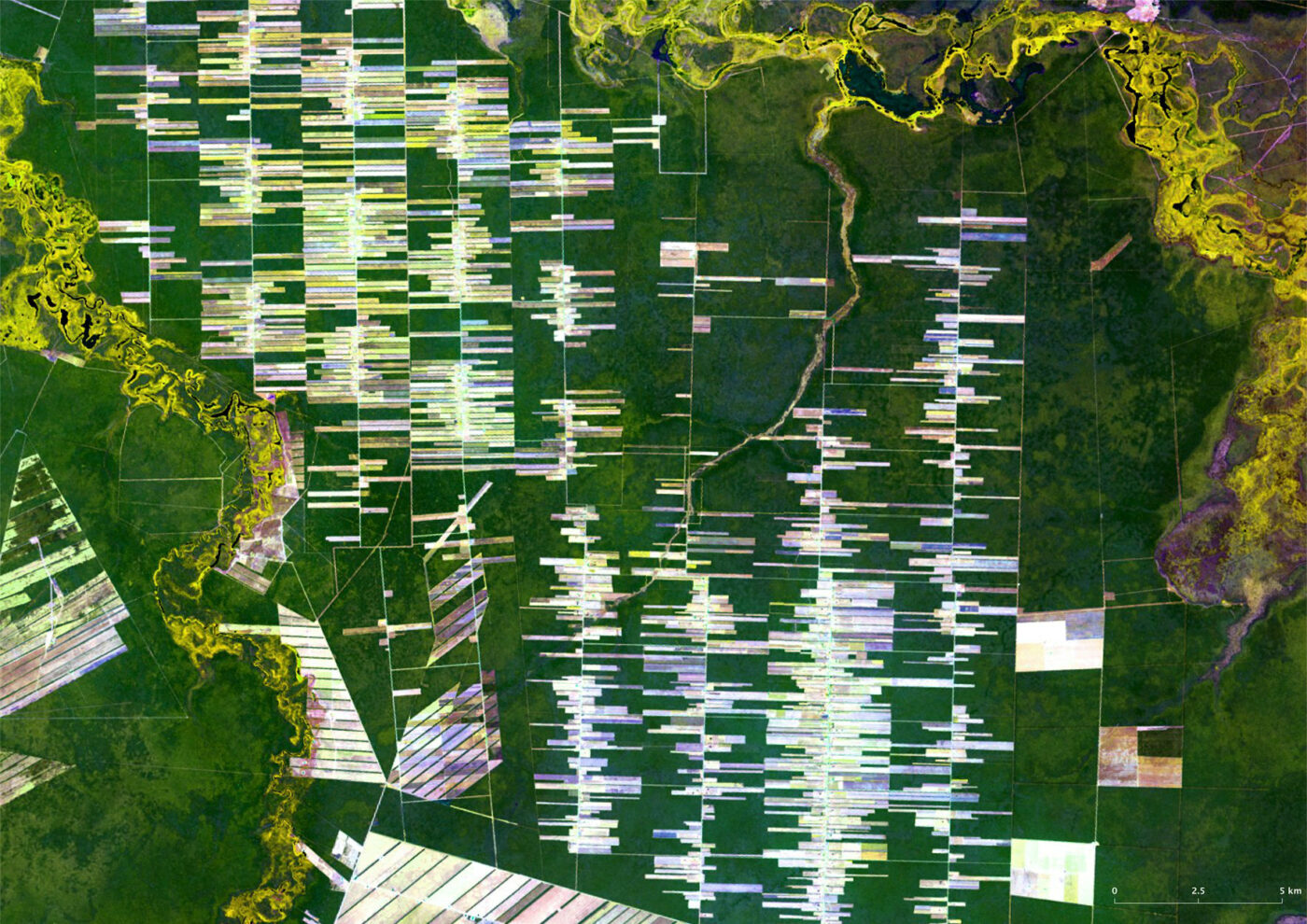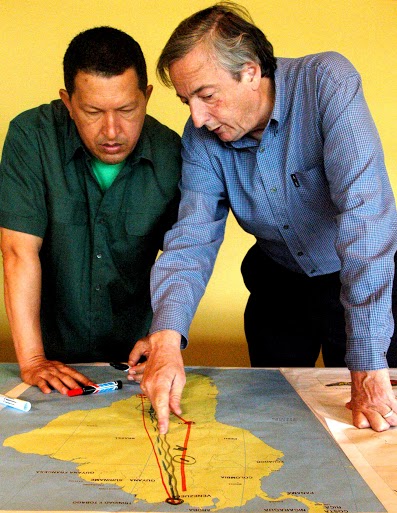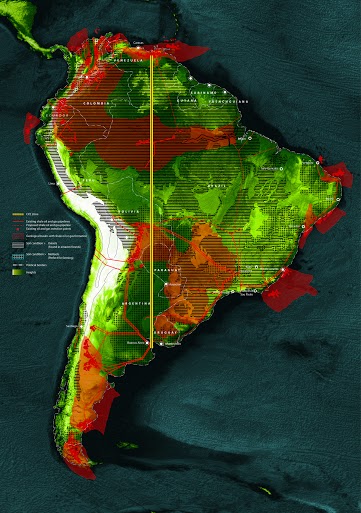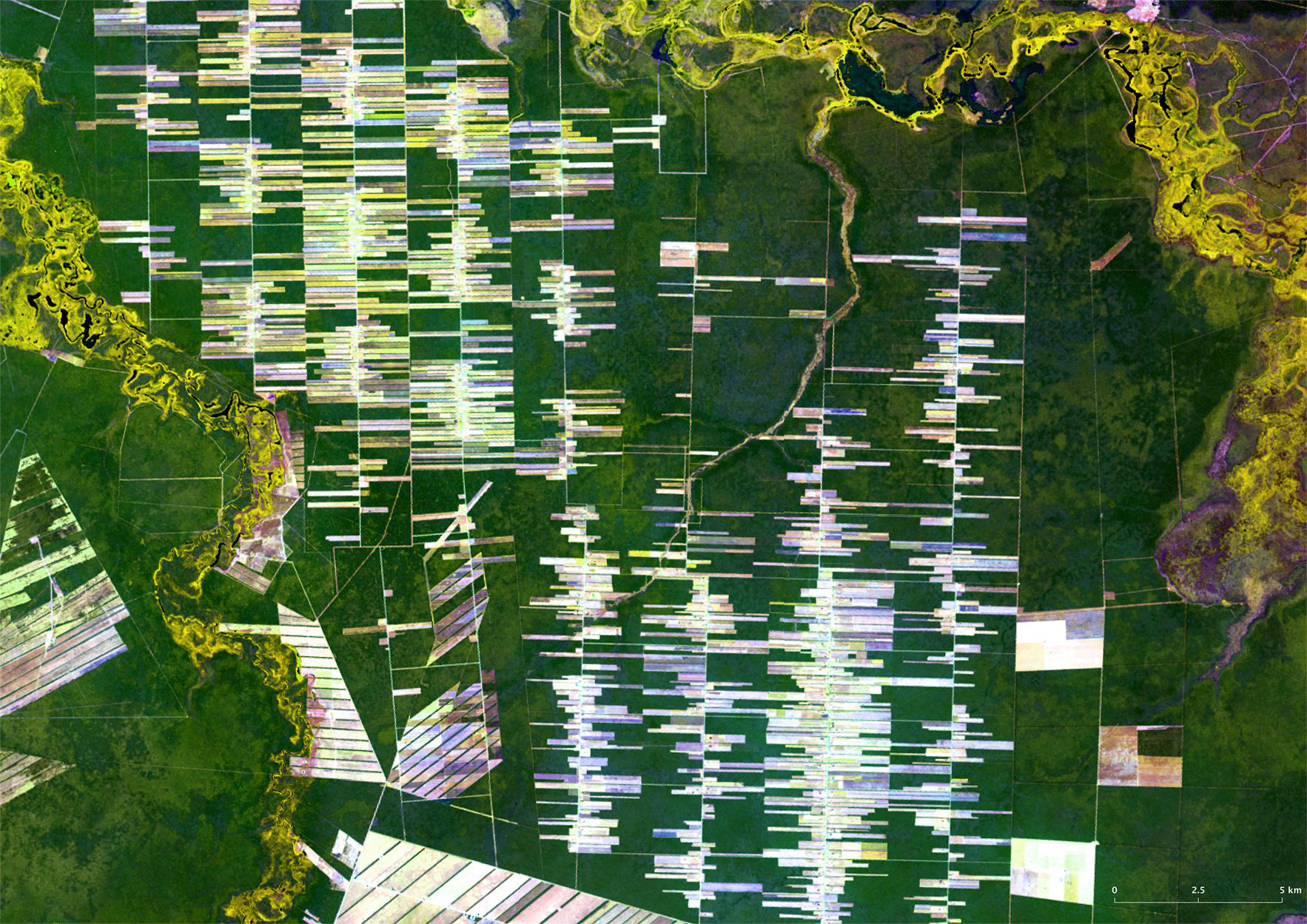The Project of a Collective Line

Latin America is a place, but it’s also a project. Its history as a colonial project gave birth to a radical one of decolonization. With revoutionaries like Simón Bolívar and José de San Martin, the idea of Latin America as a collective whole emerged and has persisted up to this day. Godofredo Pereira looks at the failed proposal of a pipeline running between three countries to question whether such a mechanism can’t be used to realize such a project, that of Latin America itself.
In 2006 Venezuelan President Hugo Chávez, Brazilian President Lula da Silva and Argentinean President Néstor Kirchner proposed the construction of a gas pipeline connecting Venezuela to Brazil and Argentina, called the Gran Gasoduto del Sur. Although the project was never built, its path through the Amazon rainforest foregrounds the violent nature of resource extraction. At the same time, the project raised unique questions regarding the architecture of collective politics, particularly if understood in the context of the last fifteen years of political transformations throughout Latin America.
Neo-extractivism
We are now in the end of a fifteen-year cycle that has witnessed a ‘turn to the left’ in Latin America. We can see this in the elections of Hugo Chávez in Venezuela, Lula da Silva and Dilma Rouseff in Brasil, Evo Morales in Bolivia, Nestor and Cristina Kirchner in Argentina, Tabaré Vásquez and Pepe Mujica in Uruguay, Fernando Lugo in Paraguay and Rafael Correa in Ecuador. Most of these electoral victories emerged not only due to a discourse against colonial exploitation and post-colonial expropriation – a feeling of injustice underlined in the book Open Veins of Latin America [1] – but also due to the continent’s submission in the eighties and nineties to the Washington Consensus and its policies of liberalization and free trade.[2] Against this, social movements and popular non-governmental organizations emerged during these decades as important political actors. Examples such as the popular uprising known as the Caracazo in Venezuela in 1989, the Zapatista struggles in Mexico in 1994, the prominence gained by the MST in Brazil from the mid-eighties,[3] the CONAIE in Ecuador and other indigenous organizations in Peru and Bolivia were instrumental both in resisting previously implemented economic and political models and in maintaining the struggle for a different form of politics alive.[4] These and many other social movements were part of broad coalitions without which governmental elections wouldn’t have been won. It is from within this context that sociologist Eduardo Gudynas coined the term neo-extractivism. The term refers to this wave of left-leaning or ‘progressive’ governments and how they have adopted interventionist policies around resource extraction, such as strengthening the role of the state, changing contractual arrangements with transnational investors, raising rents and taxation regimes, etc.[5] In so doing, governments like those of Kirchner and Chávez managed to wrest some degree of control over their sovereign territories away from transnational corporations and fund a series of re-distributive policies.
Venezuela was paradigmatic in this sense. In the eyes of the government elected in 1999 under the leadership of Hugo Chávez, oil would allow not only a radical break with the economic models of the 1990s, but the opportunity to implement a series of political shifts at multiple scales: from broad social programs to the re-structuring of the agricultural sector; from the upgrading of national infrastructure to the establishing of new global partnerships. As in many other global cases, underground resources were seen as the motor of development and a way to exit the condition of colonial dependency that Venezuela had been stuck in for so many years. But to do so it needed to create conditions to insulate itself from the constant political pressure and power of its main trading partner, the US. Contrary to previous governments, with Chávez, the availability of oil enabled the development of a ‘multi-polar’ geopolitical strategy and the development of – by way of financing – regional alliances and partnerships at the scale of the global South. Within this new frame Venezuela reinforced its position in OPEC, became a partner of MERCOSUR, participated in the creation of UNASUR, and created ALBA, an organization that promotes economic integration based on social welfare in response to the liberal policies of FTAA.[6] Important trading partners were found outside of Latin America too, such as Russia, Iran and China. Considering that these partnerships rely heavily on oil and gas trading, they can be seen as an extended map of oil’s ‘political affordances’. In this sense, the Chávez government’s establishment of PetroCaribe, PetroSur and PetroAndes was clearly directed towards cementing ties with the three main cultural areas that influence Venezuela – Caribbean, South American and Andean countries.
Gran Gasoducto del Sur
The Gran Gasoducto del Sur was a proposal first formalized at the XXIX MERCOSUR meeting in Montevideo on 9 December 2005. In this meeting, energy ministers from Venezuela, Argentina and Brazil signed a deal for the development of an 8000-15000km gas pipeline to connect the three countries. On the 19 January 2006, presidents Hugo Chávez, Nestor Kirchner and Lula da Silva approved the project and gave it its name in a meeting in Brasilia. The gigantic gas duct would connect Puerto Ordaz in Venezuela to Buenos Aires in Argentina. In addition to this, it would allow pipelines to be connected to other South American nations. This project was the most daring of all interventions in the political process of regional integration and economic sovereignty. The photo-op of a later encounter shows Chávez and Kirchner tracing a straight line through the Venezuelan and Brazilian rainforest and the Bolivian, Paraguayan and Argentinean plains. These lands are some of the most protected areas of the world, and the leaders were apparently indifferent to the environmental and indigenous concerns that would be raised by the implementation of such a project. The inherently modernist nature of such a gesture foregrounds what has been a key political dispute within the left in Latin America: on the one hand, a common political project of national and regional sovereignty based on resource nationalization and, on the other, massive social movements of landless peasants, indigenous populations and environmental activists, fighting back against the expansion of these very extractive economies. The sheer immensity of the very idea of the Gran Gasoducto del Sur project makes evident not only the dubious ecological impact of a political project based on resource extraction but also the differences between popular movements and progressive governments. It could be said that the tension between a modernizing desire to guarantee autonomy against neoliberal policies by way of resource extraction and the proposals for alternative (non-modern) forms of development brought forth by multiple social movements are an unresolved feature of every country in the area.

The Gran Gasoducto del Sur project didn’t keep the image of the straight line that was drawn by Chávez and Kirchner. In its most advanced stage it connected key Brazilian cities such as Fortaleza and Brasilia (avoiding the Amazon rainforest) and from there to Montevideo in Uruguay and finally to Buenos Aires in Argentina. In the end the project was abandoned, partially due to indigenous and environmentalist protests, and partially due to Brazil’s state-owned oil company Petrobras backing out. In any case, its implicit construction of a ‘collective line’ can be read in two opposing ways:
As Venezuelan sociologist Maria del Pilar García-Guadilla notes, most of the institutions and intergovernmental partnerships of regional integration created by South American governments were thought of as mechanisms for their integration into the global economy and emphasized the need for trade liberalization amongst members.[7] For example, one of the common features to all these agreements was the support for the Initiative for Integration of Regional Infrastructure in South America (IIRSA). IIRSA’s aim was (and still is) the development of an infrastructural network of roads, dams, ferries, airports and fiber-optic cables throughout the South American continent, connecting the region’s major cities and logistic centers to facilitate economic growth. Implicit to IIRSA is the ‘favoring of flows over territories inhabited by peoples and nations’ as noticed among others by social movements theorist Raúl Zibechi.[8] Of course, by territories and nations, Zibechi was referring not to nation-states but to the inhabitants of the South American hinterlands and in particular to its indigenous peoples. Understood within the context of IIRSA, the mode of integration the Gran Gasoducto was part of is that of modernist spatial planning: a logistic carving of territory to facilitate the extraction and circulation of resources as motors of progress and development, from mining to hydrocarbons and forestry.
A Collective Line
At first sight the idea of the collective implicit in the Gran Gasoducto del Sur falls back on unfortunately well-known modernist paradigms. However, the proposal also pointed to an idea of a collective that is transversal to the peoples of Latin America. This idea can be traced back to Simon Bolívar and José de San Martín, the key military commanders of the independence wars against Spain, and their proposals of Pan-Hispanic unity. They ultimately failed to prevent the subdivision of Central and South America into multiple different countries, but the idea remained alive and was made famous by the words of Cuban poet José Marti and Argentinian writer Manuel Ugarte.[9] Comporting to this idea of a collective, one should remember that after Argentina’s dramatic financial crisis of 2002 it was Venezuela’s buying of restructured Argentine bonds that allowed Kirchner’s government to remain viable.[10] The gas duct connecting both countries would further cement such friendship – a possibility of Latin American solidarity that is evident in the image of the two presidents embarking on a megalomaniacal re-design of the continent by drawing on a map with a thick felt-tipped marker. But if this is the case, the power of the line was realized simply by tracing it on paper, simultaneously as a connection and as a rupture with the ‘no alternative’ TINA paradigms.[11] The line marked the possibility of a coming together between peoples and the possibility of inscribing a different politics in space. In starting with that line, that gesture, the project evidenced something very different from other IIRSA infrastructural projects: it was first and foremost moved by transformative politics and by a collective project.

In 2014 together with Samaneh Moafi I proposed to explore the key ideas of the Gran Gasoducto del Sur project in the context of an architectural design competition.[12] We named it the Great South American Pipeline. We understood Chávez and Kirchner’s idea as a continuous monument to Latin America’s struggles for emancipation and as a manifestation of solidarity between countries. Seen in this light it was a unique gesture. Our project consisted of foregrounding this gesture of both cutting and bringing together as an eminently architectural one. In spite of its name, our proposal didn’t limit itself to simply building the gas duct as originally planned. Instead, it suggested that the project should be radicalized to its furthest political and spatial consequences – to the point where the circulation of hydrocarbons acts in the spirit of the Venezuelan constitution, or, as Chávez would say, as ‘an instrument of liberation and cooperation.’ To be clear, if anything defined the tenure of Chávez as President it was the implementation of a redistributive politics – ‘sowing’ the money of oil to fund healthcare, literacy, housing, etc.[13] As in Brazil and Argentina, the social transformation and the fight against inequality in Venezuela was an extraction-based project. But in our view, that project needed to move beyond such a modernist position and take into account demands set by the social movements from whence this progressive wave of Latin American governments came to power; demands not only for social justice, education and healthcare, but also for indigenous rights, for other paradigms of development and for environmental protection against the extractive industries themselves.
We thus proposed to reconceive the Gran Gasoduto del Sur as a collective line at the scale of Latin America whose revenues would pave the way for projects aimed to move away from an extraction-based economy. In its first installment this could take the shape of a commons-protection-zone, a special jurisdiction established alongside the gas duct and any future expansion of it. This implies that in order to transport gas, the member country would have to refrain from extractive activities along the 1km-wide line (including agribusiness and forestry) and instead promote other modes of production. The transportation of gas would be limited to the time period necessary to pay for the development of the commons protection zone, after which it would be dismantled.
Our purpose was to avoid a simplistic opposition of resource-extraction vs. environmental concerns. Instead, we wondered if it was possible to take seriously the mythical Latin American project: the construction of a collective that both recognized and respected the perspectives of social movements and indigenous organizations, while at the same time being both able to balance the pre-existent extreme inequalities in South America and survive the economic pressures of international financial institutions. From here the project became a form of enquiry: along the line traced by Chávez and Kirchner are located some of the most disputed lands in South America, from which we identified five cases. The Orinoco Oil belt in Venezuela, which has already born witness to drastic environmental contamination by the oil industry; Rondônia in Brazil, whose forests have been devastated by accelerated urbanization and farming; Santa Cruz in Bolivia, where soybean plantations are forcing a massive deforestation and dispossession of indigenous communities; Chaco forest in Paraguay, whose unique biodiversity is being destroyed by large scale cattle herding; and Villa 31 in Argentina, a slum at the center of a dramatic dispute over urban regeneration and the rights to the city. Our initial project did not propose a design for each condition. Instead, we wanted to evidence the spatial and territorial realities within which a collective line would have to be imagined. For us the line was the beginning of a research project on the architecture of a possible solidarity between the peoples of Latin America.

The Architecture of Solidarity
The Gran Gasoducto del Sur project marks a period of radical political transformations in Latin America. For the first time a cohort of progressive left-wing parties were in power. Its heroic dimension is thus indiscernible from the horizons opened by these socio-political ruptures. Surely, the Gasoducto was a logistical project aimed at a mode of regional integration based on resource extraction and the circulation of capital. However, it was firstly a project of political and material transformation. Underlying the difference between an infrastructural and a political understanding of the pipeline proposal are two very different conceptions of territory. The first conceives of territory within the tradition of the sovereign nation-state: territory as a political technology for the management and administration of the state as a productive apparatus.[14] This notion of territory takes as its key object the management of circulation, be it of peoples and commodities. It is, at heart, a military and logistic enterprise; it is the project of IIRSA and of which, as many have argued, the Gran Gasoducto is part. The second conceives of territory as the project of Patria Grande or Nuestra America, of a projected collective identity that informed the transformative politics of ‘revolutionaries’ such as ‘Ché’ Guevara or Hugo Chávez. This is not a conception of territory as a clearly defined space, but as an assemblage permanently under construction. More precisely, it is a matter of territorializing – a semiotic practice that takes place through gestures, signs or sounds, through literature as well as spatial interventions.[15] In this sense the line traced by Chávez and Kirchner is a political gesture that in marking space territorializes a collective project.
But if the project of the Gran Gasoducto is of a collective, then the question is how can such collective encompass the perspectives of social movements and indigenous peoples? In its path across South America, the line traced by Chávez and Kirchner intercepted territories that are neither those of the nation-state’s fixed borders nor those of an imagined Pan-Hispanic union. It intercepted collective territories that don’t necessarily have physical limits or borders and that correspond to a multitude of particular modes of living and singular worldviews;[16] collective territories of which forests, stones and spirits are often part and the languages spoken are neither Spanish nor Portuguese. If there was something unique in the emergence of social movements as key political actors throughout Latin America it was the space conquered for alternative notions and practices of territory and the possibility of coexistence between radically different modes of living and conceiving the world. Despite the fact that most progressive governments have slowly returned to the old ways of extracting and plundering, it is still towards such a collective project that we should be aiming for. And as architects we cannot but ask ourselves what such a project could be.
References
1. This book was given to Barack Obama by Hugo Chávez upon their first meeting. Eduardo H. Galeano, Open veins of Latin America: Five Centuries of the Pillage of a Continent (London: Serpent’s Tail, 2009).
2. This is an opinion on Latin American politics shared by many authors. See Raúl Zibechi, Territorios en resistencia. Cartografía política de las periferias urbanas latinoamericanas (Baladre, Zambra, Ecologistas en Acción y CGT, Málaga, 2012); Emir Sader, The New Mole: paths of the Latin American left (London, New York: Verso, 2011); Patrick S. Barret, Daniel Chavez, and César A. Rodríguez Garavito (eds.), The New Latin American Left: Utopia Reborn (London: Pluto Press, 2008).
3. The Landless Workers Movement – in Portuguese Movimento dos Trabalhadores Sem Terra – emerged in 1984 in Brazil from a long history of landless peasants and small farmers struggles for the right to farm idle land and for justice in land distribution. See http://mstbrazil.org/
4. See Atilio A. Borón, ‘Promises and Challenges: The Latin American left at the Start of the Twenty-first Century’. In: ibid., Barret, Chavez, Rodríguez Garavito.
5. Gudynas, Eduardo, 2009, ‘Diez Tesis Urgentes Sobre El Nueveo Extractivismo: Contextos y demandas bajo el progresismo sudamericano actual’. In: Extractivismo, Política y Sociedad (Quito: Centro Andino de Acción Popular, Centro Latinoamericano de Ecologia Social, 2009).
6. ALBA is the acronym for the Bolivarian Alliance for the Peoples of Our America, or in Spanish the Alianza Bolivariana para los Pueblos de Nuestra América; The Free Trade Area of the Americas was an expansion of the North American Free Trade Agreement (NAFTA), perceived as a foreign policy tool of the US government. This was perceived to be the implementation mechanism of US policy.
7. María del Pilar García-Guadilla, “Neo-extractivismo, Neo-rentismo y Movimientos Sociales en la Venezuela del Siglo XXI: conflictos, protestas y resistencia.” Conference paper presented at the XXXI International Congress of the Latin American Studies Association (LASA). Washington D.C.
8. Raul Zibechi, “Interconexión sin integración: 15 años de IIRSA”, in Programa de Las Americas, September 23, 2015. Available online at http://www.cipamericas.org/es/archives/16490#_ftn7
9. José Marti, ‘Nuestra America’, El Partido Liberal, March 5, 1892 (Mexico City); Manuel Urgarte, ‘Patria Grande’, (Barcelona: Internacional, 1922).
10. Conrado Hornos, ‘Chávez keeps up South American energy diplomacy’, Reuters, August 8 2007. At: http://www.reuters.com/article/us-venezuela-uruguay-idUSN0835483220070808 (accessed 13 February 2016).
11. TINA is the acronym for There Is No Alternative, a slogan frequently used by Margaret Thatcher to argue for free market, free trade and labor deregulation.
12. Think Space, Money. At: http://think-space.org/en/past-themes/money/theme/ (accessed 13 February 2016).
13. In particular the government initiated the housing programme Misión Habitat, followed in 2011 by Gran Misión Vivienda Venezuela (GMVV). The purpose of this plan was to produce at least 500,000 new affordable houses per year, up to a target of 3 million residential units in the country by 2019.
14. Stuart Elden, ‘Land, Terrain, Territory’, Progress in Human Geography, 34 (6), 2010, pp. 799–817.
15. On territory see Gilles Deleuze and Félix Guattari, ‘1837: Of the Refrain’, in A Thousand Plateaus Capitalism and Schizophrenia (London: Continuum, 2008).
16. For a discussion of the problem of territory in relation to peasant or indigenous worldviews see: Arturo Escobar, Territories of Difference: Place, Movements, Life, Redes (Durham: Duke University Press, 2008).